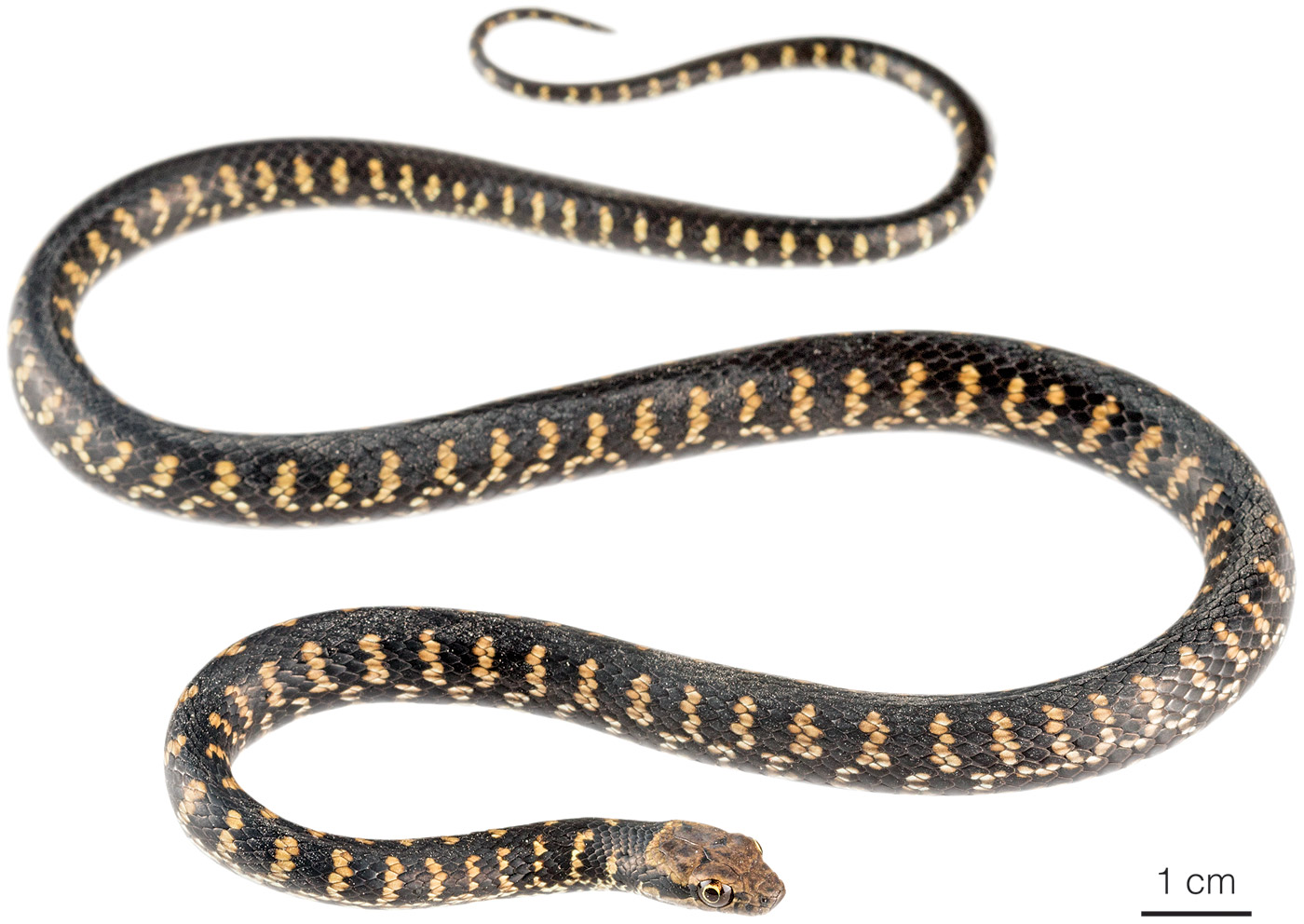Published October 10, 2019. Updated May 25, 2024. Open access. Peer-reviewed.
Darwin’s Racer (Pseudalsophis darwini)
Reptiles of Ecuador | Serpentes | Colubridae | Pseudalsophis darwini
English common name: Darwin’s Racer.
Spanish common name: Culebra de Darwin.
Recognition: ♂♂ 51 cmMaximum distance from the snout to the tip of the tail. Snout–vent length=35.7 cm. ♀♀ 54.3 cmMaximum distance from the snout to the tip of the tail. Snout–vent length=38.3 cm..1 Pseudalsophis darwini is one of two snake species known to occur on Isabela Island, Fernandina Island, and Tortuga Islet.1,2 It is characterized by having a black dorsum with a series of paired pale goldenrod yellow bars and a light brown head cap (Fig. 1).1,2 This pattern differentiates it from the striped or spotted P. occidentalis, a larger co-occurring snake.3

Figure 1: Adult male of Pseudalsophis darwini from Punta Espinoza, Fernandina Island, Galápagos, Ecuador.
Natural history: Pseudalsophis darwini is a diurnal snake that inhabits coastal volcanic rock areas, dry grasslands, and seasonally dry forests.1,2,4 During the daytime, these snakes are typically seen swiftly moving on soil and rocks.2 When not active, they have been found hidden under lava blocks, under tree bark, or beneath wooden boardwalks.5
Conservation: Least Concern Believed to be safe from extinction given current circumstances.. Pseudalsophis darwini is a recently described species.1 Therefore, it has not been formally evaluated by the IUCN Red List. Here, it is provisionally assigned to the LC category because the species is widespread in western Galápagos and is presumably not undergoing population declines nor facing major immediate threats of extinction. Fernandina is one of the most pristine islands in Galápagos and is currently free of exotic predators that may prey upon snakes. The threats that Darwin’s Racers face in Fernandina are volcanic eruptions and the potential for the introduction of aggressive exotic species, mainly rats and cats. In Isabela, the largest island of the archipelago, conservation challenges are more complex since the island has several introduced species, including humans, that may have an impact on the population of P. darwini.2
Distribution: Pseudalsophis darwini is endemic to Isabela Island, Fernandina Island, and Tortuga Islet in Galápagos, Ecuador (Fig. 2).

Figure 2: Distribution of Pseudalsophis darwini in Galápagos. The star corresponds to the type locality: Tortuga Islet. See Appendix 1 for a complete list of the presence localities included in the map.
Etymology: The generic name Pseudalsophis comes from the Greek words pseudo (=false) and Alsophis (a genus of Caribbean snakes), referring to the similarity between snakes of the two genera.1 The specific epithet darwini honors Charles Darwin.1
See it in the wild: Darwin’s Racers can be seen at a rate of about once every few days at Punta Espinoza in Fernandina Island. The best time to look for them is during the first hours after sunrise or right before sunset.
Special thanks to David Salazar-Valenzuela for symbolically adopting the Darwin’s Racer and helping bring the Reptiles of Ecuador book project to life.
Click here to adopt a species.
Authors: Alejandro ArteagaaAffiliation: Fundación Khamai, Reserva Arlequín, Ecoruta Paseo del Quinde km 56, Santa Rosa de Mindo, Pichincha 171202, Ecuador. and Juan M GuayasaminbAffiliation: Universidad San Francisco de Quito, Quito, Ecuador.
Academic reviewers: Robert A ThomascAffiliation: Loyola University, New Orleans, United States. and Luis Ortiz-CatedraldAffiliation: Massey University, Palmerston North, New Zealand.
Photographer: Jose VieiraeAffiliation: Tropical Herping (TH), Quito, Ecuador.,fAffiliation: ExSitu, Quito, Ecuador.
How to cite? Arteaga A, Guayasamin JM (2024) Darwin’s Racer (Pseudalsophis darwini). In: Arteaga A, Bustamante L, Vieira J (Eds) Reptiles of Ecuador: Life in the middle of the world. Available from: www.reptilesofecuador.com. DOI: 10.47051/WDKL3175
Literature cited:
- Zaher H, Yánez-Muñoz MH, Rodrigues MT, Graboski R, Machado FA, Altamirano-Benavides M, Bonatto SL, Grazziotin FG (2018) Origin and hidden diversity within the poorly known Galápagos snake radiation (Serpentes: Dipsadidae). Systematics and Biodiversity 16: 614–642. DOI: 10.1080/14772000.2018.1478910
- Arteaga A, Bustamante L, Vieira J, Tapia W, Guayasamin JM (2019) Reptiles of the Galápagos: life on the Enchanted Islands. Tropical Herping, Quito, 208 pp. DOI: 10.47051/AQJU7348
- Thomas RA (1997) Galápagos terrestrial snakes: biogeography and systematics. Herpetological Natural History 5: 19–40.
- Cisneros-Heredia DF, Reyes-Puig C (2023) Natural history and conservation of the Galápagos snake radiation. In: Lillywhite HB, Martins M (Eds) Islands and snakes. Oxford University Press, 158–182. DOI: 10.1093/oso/9780197641521.003.0009
- Field notes, Reptiles of Ecuador book project.
Appendix 1: Locality data used to create the distribution map of Pseudalsophis darwini in Ecuador (Fig. 2). Go to the section on symbols and abbreviations for a list of acronyms used. Asterisk (*) indicates type locality.
| Country | Province | Locality | Source |
| Ecuador | Galápagos | Cabo Barrington | Cisneros-Heredia & Reyes-Puig 2023 |
| Ecuador | Galápagos | Cabo Douglas | Arteaga et al. 2019 |
| Ecuador | Galápagos | Cabo Douglas, 4 km SE of | Cisneros-Heredia & Reyes-Puig 2023 |
| Ecuador | Galápagos | Cartago Bay | Thomas 1997 |
| Ecuador | Galápagos | Centro de Crianza Arnaldo Tupiza | iNaturalist; photo examined |
| Ecuador | Galápagos | Cerro Azul, western foothills | iNaturalist; photo examined |
| Ecuador | Galápagos | Volcán Alcedo (Cowley Mountain), eastern slope | Fritts and Fritts 1982; Thomas 1997 |
| Ecuador | Galápagos | Piedras Blancas | Zaher et al. 2018 |
| Ecuador | Galápagos | Puerto Villamil | Zaher et al. 2018 |
| Ecuador | Galápagos | Puerto Villamil, 16 km NE of | iNaturalist; photo examined |
| Ecuador | Galápagos | Punta Espinosa | Arteaga et al. 2019 |
| Ecuador | Galápagos | Punta Espinoza, 4 km S of | iNaturalist; photo examined |
| Ecuador | Galápagos | Punta Moreno | Arteaga et al. 2019 |
| Ecuador | Galápagos | Tagus Cove, 3 km N of | iNaturalist; photo examined |
| Ecuador | Galápagos | Tortuga islet (Brattle)* | Zaher et al. 2018 |
| Ecuador | Galápagos | Villamil, 4 km E of | iNaturalist; photo examined |